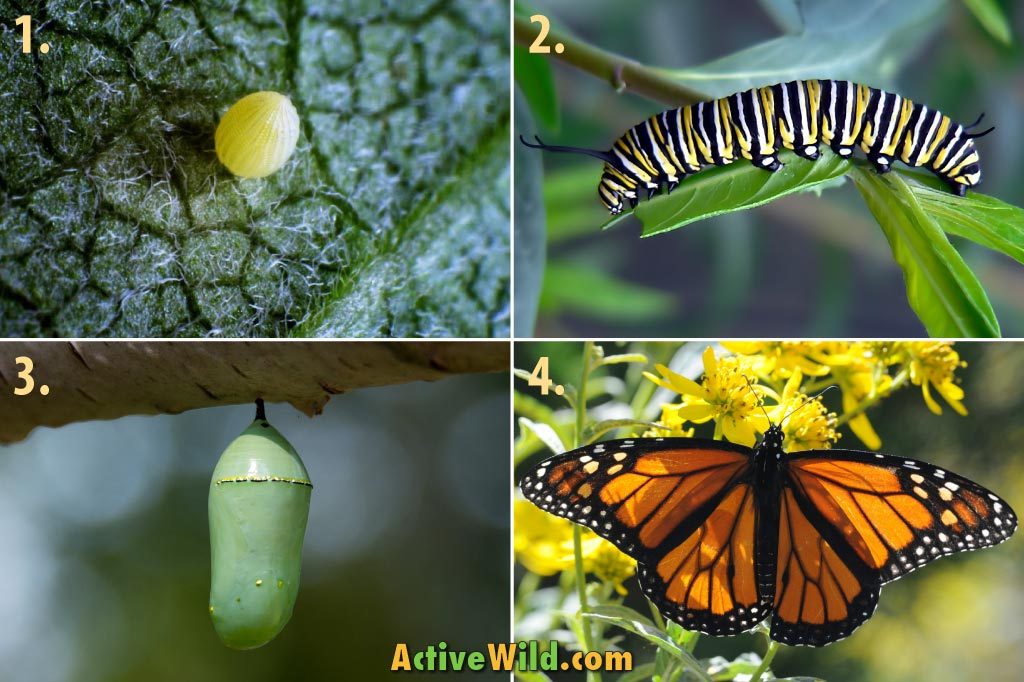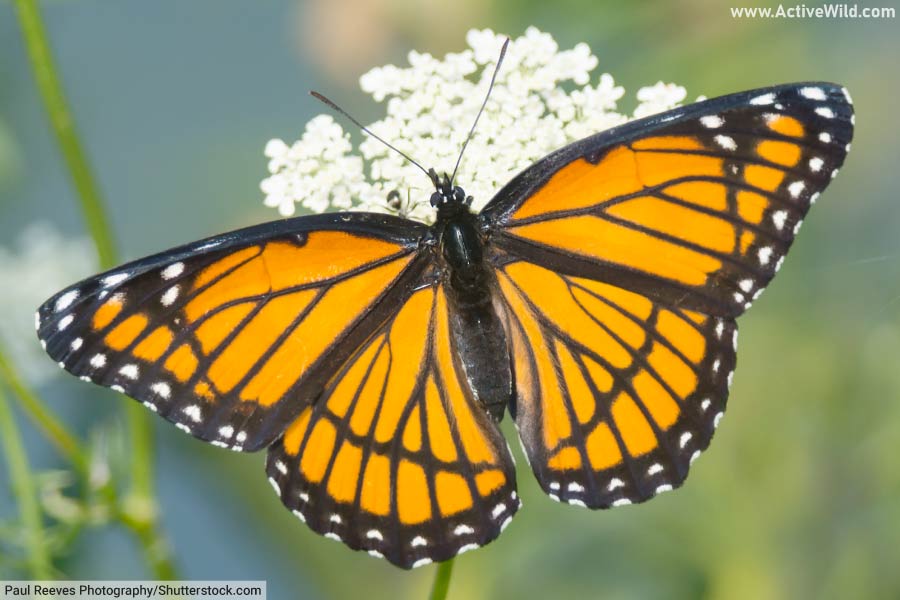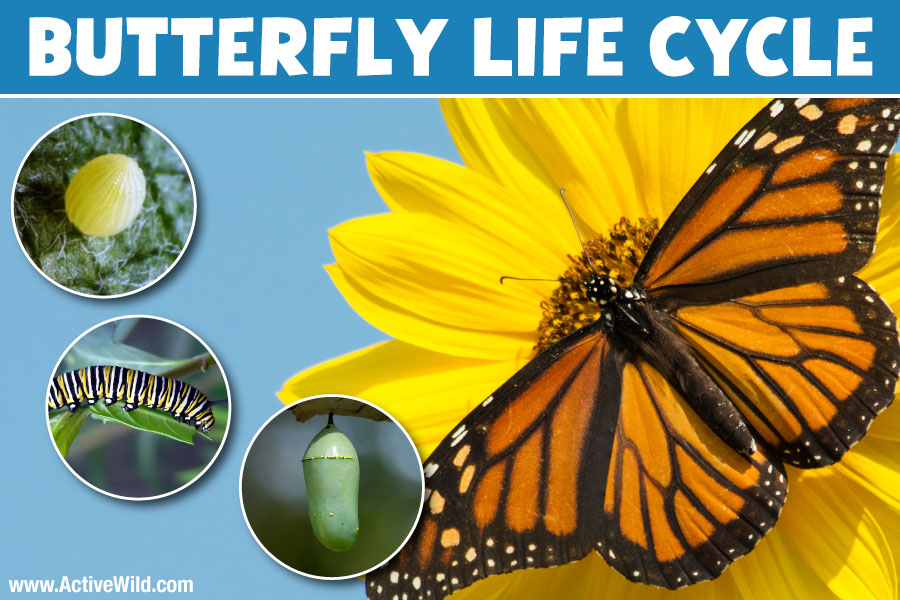An explanation of the butterfly life cycle, with pictures and facts.
Introduction
Butterflies aren’t born as the large-winged, brightly-colored insects we see in our gardens and parks. Instead, the life cycle of a butterfly involves four separate stages, during which the bodies of these familiar insects undergo a remarkable change known as metamorphosis.
Although many insects have the same four-stage life cycle as butterflies, the emergence of an adult butterfly from its chrysalis is one of the most spectacular examples of this process.
(Further down the page we compare the life cycle of a butterfly with that of other insect groups.)
Page Contents
- Life Cycle Of A Butterfly
- The Stages Of The Butterfly Life Cycle In Detail
- Eggs
- Larvae
- Pupae
- Imago
- Complete Metamorphosis (Holometabolism)
- Do All Butterflies Have The Same Life Cycle?
- Butterfly vs Moth Life Cycle
- Incomplete Metamorphosis (Hemimetabolism)
- Do All Insects Undergo Metamorphosis?
- Discover More with Active Wild
Life Cycle Of A Butterfly

The life cycle of a butterfly consists of four distinct stages:
- Egg: A female butterfly lays tiny, oval eggs on the leaves or stems of plants that will serve as food for her offspring. The eggs are attached to the plant with a glue-like substance secreted by the butterfly.
- Larva (Caterpillar): After hatching from the egg, the larva, commonly known as a caterpillar, emerges. This stage primarily involves feeding on plant material to grow. As it grows, the caterpillar sheds its skin several times, a process called molting.
- Pupa (Chrysalis): Once fully grown, the caterpillar attaches itself to a suitable structure (e.g., a leaf or stem) and forms a protective casing around itself called a chrysalis. Within this casing, it undergoes a remarkable transformation, known as metamorphosis, restructuring its body to become a butterfly.
- Imago (Adult Butterfly): After metamorphosis is complete, the adult butterfly emerges from the chrysalis. It then expands and dries its wings before flying off. The adult stage is primarily for reproduction, where the butterfly seeks a mate to begin the cycle anew.
Notes:
The plural forms of larva and pupa are larvae and pupae, respectively.
Imago is a term used for the adult stage in an insect’s life cycle.
The word “imago” comes from the Latin for “image”. The correct plural form of imago is “imagines”, but “imagoes” is also used.
The Stages Of The Butterfly Life Cycle In Detail
Butterfly Eggs

Butterfly eggs are the initial stage in the life cycle of a butterfly. These tiny, usually ovular structures are laid by female butterflies on specific host plants which caterpillars will feed on upon hatching.
The appearance of butterfly eggs can vary between species but they often possess intricate designs and patterns when observed closely. The outer protective layer of the egg is called the chorion, and it is permeated with tiny pores (known as aeropyles) to allow the developing embryo to breathe.

The location and coloration of the eggs, whether camouflaged or conspicuous, typically serve as a defense mechanism against predators or as an adaptation to the environment. After a certain period of time, the caterpillar (larva) emerges from the egg, marking the next phase in the butterfly's life cycle.

Butterfly Larvae (Caterpillars)

Butterfly larvae, or caterpillars, are the second stage in the butterfly's life cycle.
After emerging from the egg, caterpillars spend most of their time feeding on host plants, accumulating energy and nutrients for their upcoming transformation.

Their elongated, soft-bodied form is segmented and often adorned with various patterns, colors, hairs, or spikes. These features can serve as camouflage, deter predators, or indicate that they are unpalatable.
Caterpillars have six true legs, plus a number of additional "prolegs" located further down the body. These fleshy stubs are equipped with small hooks, known as "crochets" for gripping.

In some butterfly species, the larval stage is the only stage in which the butterfly will feed.
As caterpillars grow, they undergo a series of molts, shedding their outer skin to accommodate their increasing size.

Towards the end of this stage, the caterpillar stops eating and seeks a suitable site to progress to the pupal phase. Here, it will attach itself to a surface with silk (often hanging upside-down) and perform a final molt, revealing its pupal form.
Butterfly Pupae (Chrysalises)

Butterfly pupae, or chrysalises, represent the transformative third stage in a butterfly's life cycle.
The chrysalis is typically hard and can vary in color, sometimes mimicking its surroundings for camouflage. Within the chrysalis, the caterpillar's old body undergoes a dramatic change, reorganizing its cells and structures to form the adult butterfly.

After the metamorphosis is complete, the mature butterfly emerges from the chrysalis, dries its wings, and prepares for flight, marking the commencement of its adult phase.

Imago

The imago stage of a butterfly's life cycle refers to the fully developed adult phase. In this stage, the butterfly emerges from the pupal case, and after spending a brief time expanding its wings, is ready for flight.
In this stage, the butterfly's primary function is reproduction, although many butterfly species also feed as an imago.

The final stage of the butterfly life cycle is characterized by vibrant colors, patterns on the wings, and the iconic butterfly appearance.
Butterflies employ a range of mating strategies to ensure reproductive success:
- Hilltopping: Males fly to the highest point in an area, such as a hill or a prominent tree, to wait for females. This elevated position makes them easily visible to females.
- Pheromone Release: The butterfly releases chemical signals known as pheromones, to attract potential mates.
- Patrolling: Males fly around searching for receptive females. Once a female is located, courtship behaviors ensue.
- Lekking: The males of some species congregate in groups known as leks, displaying competitively to attract females.
- Puddle Clubbing: Males of certain species gather at wet spots or puddles to ingest minerals. These minerals are later transferred to females during mating as nuptial gifts, enhancing the survival of their offspring.
- Visual Displays: In some species, males perform aerial courtship displays to attract females.
Once mated, the female butterfly will seek out suitable host plants on which to lay her eggs, thereby completing the life cycle.

Complete Metamorphosis (Holometabolism)
The entire, four-stage process, from egg to adult butterfly, is known as complete metamorphosis, or holometabolism.
It is not just butterflies that undergo complete metamorphosis. In fact, the majority of insects (including flies, bees, wasps and beetles) have the same, four-stage, life cycle.
Only in butterflies is the pupa known as a chrysalis, and only in butterflies and moths (and a small number of other insects) is the larva known as a caterpillar.
Not all insects develop in this way. Some insects (e.g., dragonflies and cockroaches, among others) undergo what is known as an incomplete metamorphosis, without a pupal stage. Some groups of insects don’t undergo any type of metamorphosis.
You can find out more about the life cycles of other insect groups further down the page.
Do All Butterflies Have The Same Life Cycle?
All butterflies, no matter what the species, share the same, four-stage life cycle, although there may be significant differences in the timings of each stage between species.
Some butterfly species produce several generations in a single year, whereas others complete a single life cycle in one year. Some species (particularly those found in cold regions) take multiple years to complete a single life cycle.
Depending on species, butterflies may overwinter as either an egg, pupa, larva or imago.
The monarch butterfly, a migratory species, has a notable life cycle. The northward leg of its migration is split between several generations, while the return journey south is made by a single butterfly.
You can find out more about this incredible journey on this page: Monarch Butterfly Life Cycle
Butterfly vs Moth Life Cycle
Butterflies and moths have the same four-stage life cycle. The main difference between the life cycles of moths and butterflies is that the caterpillars of many moths spin a silk cocoon in which they pupate.
Butterflies and moths are closely related, together making up the order Lepidoptera. (There are around ten times as many moth species as there are butterfly species.)
You can find out more about the differences between butterflies and moths on this page: Moth vs Butterfly
Incomplete Metamorphosis (Hemimetabolism)

Partial metamorphosis, also known as hemimetabolism or incomplete metamorphosis, is a type of insect development that includes three primary stages: egg, nymph, and imago (adult stage).
Egg: The life cycle begins when a female insect lays eggs. These eggs are often deposited on or near the appropriate food source for the emerging nymphs.
Nymph (or Naiad in aquatic insects): Once the egg hatches, a nymph emerges. Nymphs resemble miniature versions of the adults but lack fully developed wings and reproductive organs.
As the nymph grows, it goes through a series of molts. With each molt, the nymph grows larger and becomes more similar in appearance to the adult. For many insects, wings develop externally in wing pads, which gradually increase in size as the nymph progresses through its various instars (developmental stages between molts).
In the case of aquatic insects that undergo partial metamorphosis (like dragonflies and mayflies), the nymphal stage is aquatic and is referred to as a "naiad." Naiads have adaptations suited for underwater life, and once their development is complete, they undergo a final molt to become winged adults.
Imago (Adult): After the final molt, the insect emerges as a fully developed adult, complete with wings (if the species has them) and reproductive organs.
Adults are responsible for reproduction, ensuring the continuation of the species.
Insects that undergo partial metamorphosis include true bugs (e.g., stink bugs and aphids), grasshoppers, dragonflies, and cockroaches, among others.
One of the distinguishing features of this type of metamorphosis is that there is no resting or non-feeding pupal stage as seen in complete metamorphosis. Instead, the nymphs are typically active and feed similarly to how the adults do.
Do All Insects Undergo Metamorphosis?
Whereas the majority of insects undergo either complete or incomplete metamorphosis, the life cycle of some primitive, wingless insects does not involve metamorphosis. Instead, the young of these species resemble adults, and after reaching sexual maturity, most continue to molt (but not metamorphosize). This type of insect life cycle is known as ametabolism.
Examples of ametabolous insects include various species of bristletails, silverfish, and firebrats.
Discover More With Active Wild
Visit our main animals page for links to animal information and a complete guide to the animal kingdom: Animals
You can find out more about insects on this page: Insects – The Ultimate Guide
Discover more invertebrates on this page: List Of Invertebrates


